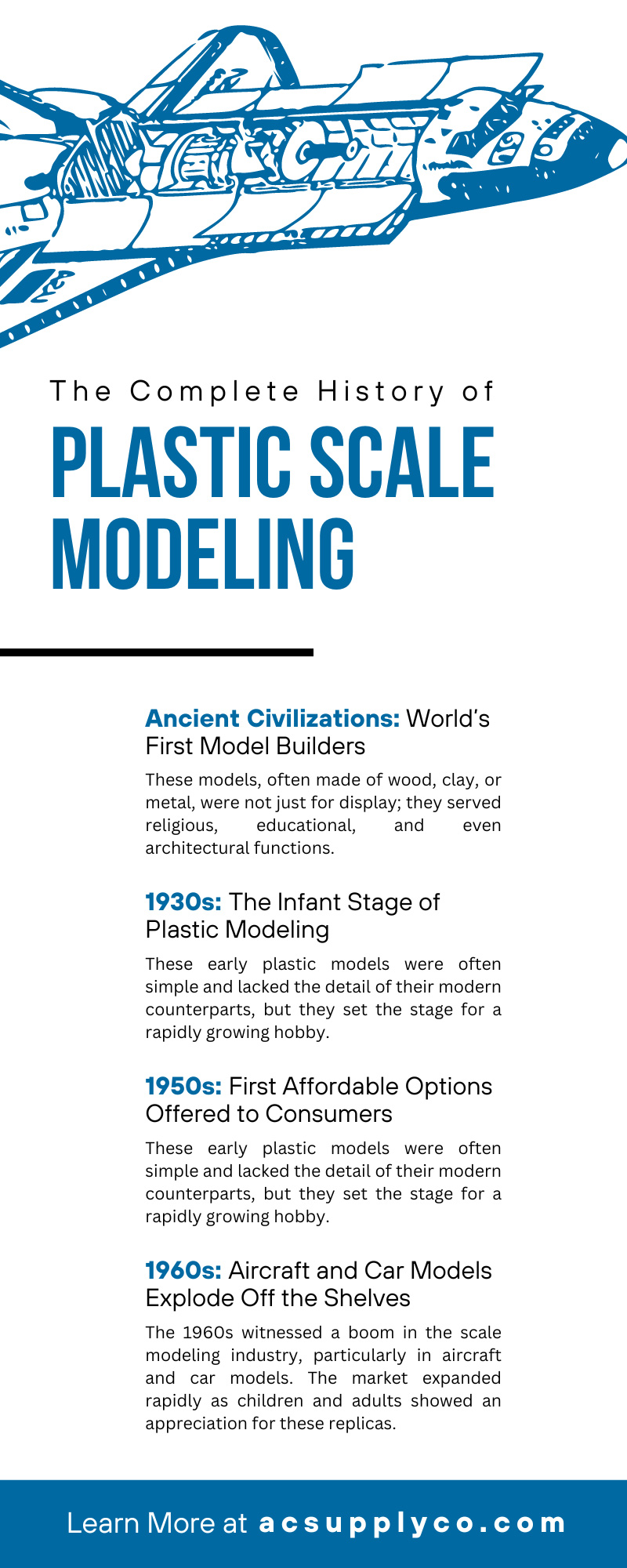You may not realize it, but plastic scale modeling exists in many aspects of our lives. For example, before a company begins manufacturing its product packaging, they build scale models to see how it will look. And before filming the movie Oppenheimer, Christopher Nolan and his team created scale models of the location for the Manhattan Project.
Since the beginning of time, model building has been a part of our educational and professional lives. The complete history of plastic scale modeling is more exciting than you would think. Continue reading to learn more about the exciting history of this incredible hobby and educational tool.
Ancient Civilizations: World’s First Model Builders
Model building has been a part of human culture since ancient times. The earliest civilizations, such as the Egyptians, Greeks, and Romans, crafted detailed models for various purposes.
These models, often made of wood, clay, or metal, were not just for display; they served religious, educational, and even architectural functions. This practice laid the groundwork for what would evolve into scale modeling as we know it today.
1930s: The Infant Stage of Plastic Modeling
The 1930s marked the dawn of plastic scale modeling. Although models existed before this era, people typically made them from wood or metal. The introduction of plastic materials, such as celluloid and polystyrene, revolutionized the industry. These early plastic models were often simple and lacked the detail of their modern counterparts, but they set the stage for a rapidly growing hobby.
How World War II Increased Interest in Plastic Scale Modeling
World War II had a significant impact on the scale modeling industry. There was a surge in public interest, particularly in military models. Manufacturers began producing tank, ship, and aircraft kits that played prominent roles in the war. This period saw an improvement in the quality and accuracy of models, reflecting the public’s fascination with the machinery of warfare.
1950s: First Affordable Options Offered to Consumers
The 1950s was a golden era for plastic scale modeling. This decade saw the introduction of more affordable options, making the hobby accessible to a wider audience. Advances in manufacturing processes allowed for more detailed and accurate models. The popularity of TV and cinema, featuring war movies and documentaries, further fueled public interest in these models.
1960s: Aircraft and Car Models Explode Off the Shelves
The 1960s witnessed a boom in the scale modeling industry, particularly in aircraft and car models. The market expanded rapidly as children and adults showed an appreciation for these replicas. Manufacturers capitalized on this trend by offering a range of models, from historical aircraft to the latest sports cars. This era marked a significant shift in scale modeling, transforming it into a mainstream hobby.
1980s: Production Peaks Due to Foreign Manufacturing
The 1980s were characterized by a peak in production, largely due to the globalization of manufacturing. Companies began outsourcing production to countries with lower labor costs, resulting in another surge in the availability and variety of kits. This period also saw advancements in molding techniques, allowing manufacturers to achieve realism in their models.
21st Century: Improved Modeling Techniques and Detailing
The 21st century has brought about remarkable improvements in modeling techniques and detailing. Advances in technology and materials have enabled manufacturers to produce models with unprecedented accuracy and intricacy. This era has shifted toward more niche and specialized models, catering to a diverse and sophisticated audience of modelers.
The Impact of Computer-Aided Design (CAD) and 3D Printing
Computer-aided design (CAD) and 3D printing have revolutionized scale modeling, allowing modelers to create intricate designs with unprecedented precision. These technological advancements have improved the quality of models and democratized the creation and distribution of unique and personalized kits.
Anyone with a computer and 3D printer can now make plastic scale models. You can create intricate parts and models from your house that rival the best manufacturers in the world.
Additionally, the development of virtual reality (VR) and augmented reality (AR) technologies has provided new ways for modelers to interact with their creations. These immersive technologies allow modelers to explore their models in a virtual environment, adding a new layer of realism and interactivity to the hobby.
The Future of Plastic Scale Modeling: Sustainability and Innovation
As we move further into the 21st century, the future of plastic scale modeling lies in sustainability and innovation. There is growing awareness about the environmental impact of plastic waste, prompting manufacturers to explore eco-friendly alternatives. Biodegradable plastics and recycled materials are gaining traction in the industry, reflecting a global shift toward sustainable practices.
Even today, innovation continues to drive the industry forward. Advances in manufacturing techniques, such as multi-material 3D printing and nanotechnology, push the boundaries of what is possible in scale modeling.
Furthermore, the rise of artificial intelligence (AI) and machine learning creates new opportunities for automating and enhancing the design process. As we look to the future, it’s clear that the history of plastic scale modeling has many exciting developments on the horizon.
How Educators Can Increase Interest in Model Building
Educators play a crucial role in nurturing interest in model building. By incorporating model kits into STEM (Science, Technology, Engineering, and Mathematics) curricula, teachers can provide hands-on learning experiences that are educational and engaging. Model building fosters problem-solving, creativity, and attention to detail, making it a valuable educational tool.
Professional development is key to promoting educational model building. Teachers can guide and inspire their students in this creative pursuit by equipping themselves with the necessary skills and knowledge. Many resources are available online and offline for educators to enhance their knowledge in this area, including workshops, webinars, and forums.
The complete history of plastic scale modeling is a fascinating journey. From its humble beginnings to the sophisticated models of the 21st century, plastic scale modeling continues to captivate and inspire generations of enthusiasts.
Today, educational model kits serve as a leisure activity and a means of learning and expressing creativity. AC Supply provides educators and parents with many educational models to excite children about learning. We have something for every age range, from plastic model airplanes to scenic dioramas. Visit our website to explore our selection of fun, educational science projects!



